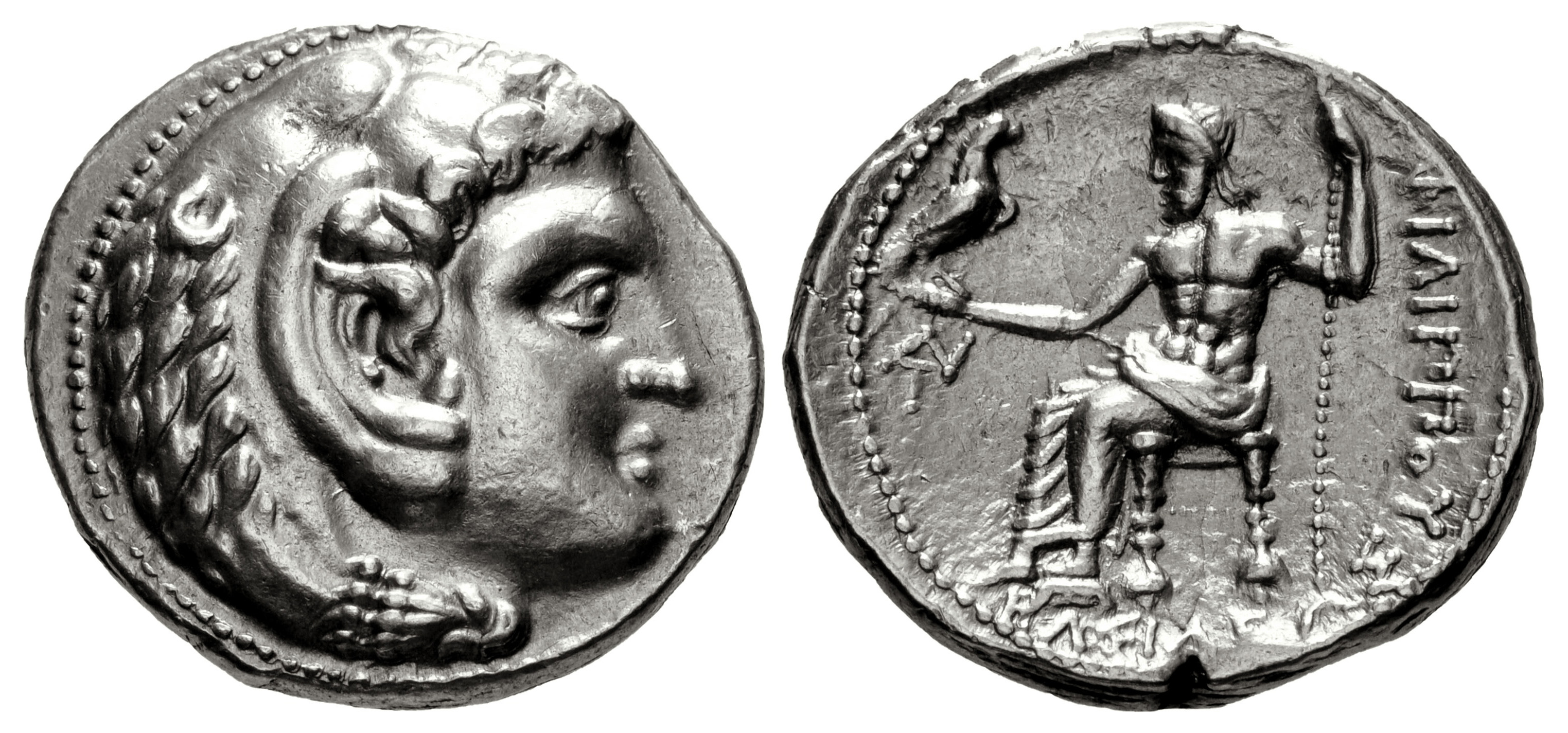Babylonia (Uncertain mint 6) (Seleucus I), silver, tetradrachms (Heracles/seated Zeus) (318-301 BCE)
From SILVER
318 BCE - 301 BCE Silver 22,815 kg
Description
| ObverseInscription or printing placed on the obverse.: | https://pro.coinarchives.com/a/lotviewer.php?LotID=1660172&AucID=3523&Lot=151 |
| ReverseInscription or printing placed on the reverse.: | ΦΙΛΙΠΠΟΥ ΒΑΣΙΛΕΩΣ (Greek).Zeus Aëtophoros seated left, monogram in left field |
Mint and issuing power
| MintIdentifies the place of manufacture or issue of a numismatic object.: | Babylonia (uncertain mint) | Ancient regionAncient region.: | Babylonia | Modern countryModern country: Iraq | AuthorityIdentifies the issuing power. The authority can be "pretended" when the name or the portrait of X is on the coin but he/she was not the issuing power. It can also be "uncertain" when there is no mention of X on the coin but he/she was the issuing power according to the historical sources: | Alexander III the Great (Argead king, 336-323 BC), Seleucid Dynasty (312-63 BC), Seleucus I Nicator (satrap in 321-305 BC and Seleucid king in 305-281 BC) |
Chronology
| FromIdentifies the initial date in a range assigned in a numismatic context. | 318 BCE | toIdentifies the final date in a range assigned in a numismatic context.. | 301 BCE | PeriodTime period of the numismatic object.: Hellenistic 323-30 BC |
Physical description
| MetalThe physical material (usually metal) from which an object is made.: | Silver |
Median weightMedian of the weights of numismatic objects (in grams). in grams | 17.10 | DenominationTerm indicating the value of a numismatic object. Examples: tetradrachm, chalkous, denarius.: | tetradrachm |
StandardStandard.: | Attic |
Image

S1911 Seleucus I babylonia Mint 6.jpg [1]
References
| Die study referencePublication of the study: | Taylor 20151Taylor 2015 | ||
| Coin series referenceReference to coin series study: | Price 19912Price 1991, n° P225, HGC 93HGC 9, n° 11a | ||
| Coin series web referenceCoin series web references: | |||
Obverse dies distribution
| FrequencyFrequency of specimen in distribution. ᵖ | Number of obversesNumber of obverse dies. ᵖ (o) | % (o) | Number of coinsNumber of coins. (n) | % (n) | Die nameName(s) of the die(s). |
| 1 | 26 | 44.83 | 26 | 10.61 | 1, 2, 3, 4, 5, 6, 7, 9, 10, 12, 27, 28, 29, 30, 31, 34, 36, 39, 40, 42, 43, 44, 45, 51, 52, 53 |
| 2 | 4 | 6.9 | 8 | 3.27 | 14, 15, 35, 38 |
| 3 | 6 | 10.34 | 18 | 7.35 | 8, 19, 24, 37, 49, 58 |
| 4 | 2 | 3.45 | 8 | 3.27 | 23, 54 |
| 5 | 2 | 3.45 | 10 | 4.08 | 21, 25 |
| 6 | 6 | 10.34 | 36 | 14.69 | 11, 32, 33, 41, 47, 48 |
| 7 | 1 | 1.72 | 7 | 2.86 | 17 |
| 8 | 5 | 8.62 | 40 | 16.33 | 16, 18, 20, 22, 46 |
| 9 | 2 | 3.45 | 18 | 7.35 | 13, 56 |
| 11 | 1 | 1.72 | 11 | 4.49 | 26 |
| 12 | 1 | 1.72 | 12 | 4.9 | 55 |
| 24 | 1 | 1.72 | 24 | 9.8 | 50 |
| 27 | 1 | 1.72 | 27 | 11.02 | 57 |
| Total | 58 of 58 | 99.98 | 245 of 245 | 100.02 |
Reverse dies distribution
no distribution is available
Quantification
| Number of obversesNumber of obverse dies. ᵖ (o) | 58 | Number of singletons (o1)The number of singleton coins. ᵖ | 26 |
| Number of reverse diesNumber of reverse dies. (r) | Number of coinsNumber of coins. (n) | 245 | |
| Coins per obverse dieNumber of coins per obverse die. (n/o) | 4.22 | Coins per reverse dieNumber of coins per reverse die. (n/r) | |
| Reverse per obverse ratioRatio of obverse dies divided by reverse dies. (r/o) | Percentage of singletons (o1)number of coins (n) divided by the number of singletons (o1) ᵖ | 44.83 % | |
| Original number of dies (O) (Carter 1983 formula)The estimation of the number of coins according to Carter 1983 ᵖ | 66.71 | Coins struck if 20,000 as average productivity per dieCoins made if the average productivity for obverses (according to Carter) is 20,000. ᵖ | 1,334,200 |
| Original number of dies (O) (Esty 2011 formula)The estimation of the number of coins according to the singleton formula in Esty 2011 ᵖ (O) | 75.99 | Survival rate if 20,000 as average productivity per dieSurvival rate if average productivity is 20,000. ᵖ | 0.00018 |
| Coverage (o = % of O) (Esty 1984 formula)Esty 1984 - coverage (% of O) ᵖ (o = % of O) | 89.39% | Die productivity if survival rate 1/2,000Average productivity if survival rate is 1/2,000. ᵖ | 7,345.23 |
| Weight of silver (in kg) if 20,000 coins per die (O = Carter formula)Carter 1983 * Median weight * 20000 (*10 if gold or electrum) ᵖ | 22,815 kg <br /> 22,815 kg | Die productivity if survival rate 1/5,000Average productivity if survival rate is 1/5,000. ᵖ | 18,363.06 |
Remarks
Most likely one single workstation Likely military
References
- ^ Taylor, Lloyd W. H. (2015), "From Triparadeisos to Ipsos: Seleukos I Nikator’s Uncertain Mint 6A in Babylonia," American Journal of Numismatics, 27, p. 41-97.
- ^ Price, Martin Jessop (1991), The Coinage in the Name of Alexander the Great and Philip Arrhidaeus: a British Museum Catalogue, 2 vol., Zürich-London, 637 p., 637 p., clix pl.
- ^ Hoover, Oliver D. (2009), Handbook of ancient Syrian coins : royal and civic issues, fourth to first centuries BC, The Handbook of Greek Coinage 9, Lancaster, lxix, 332 p.